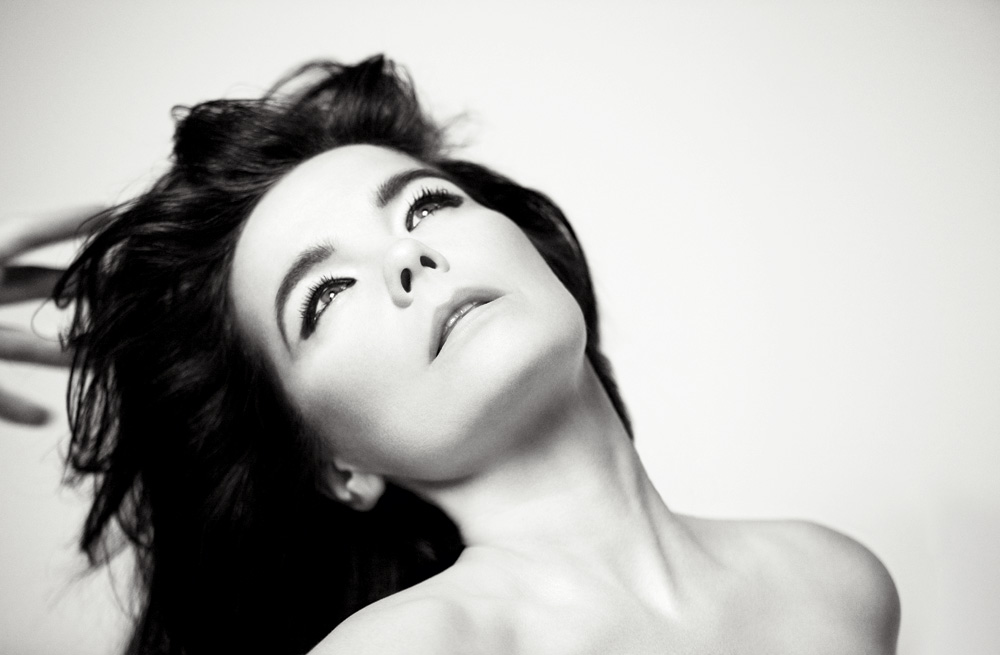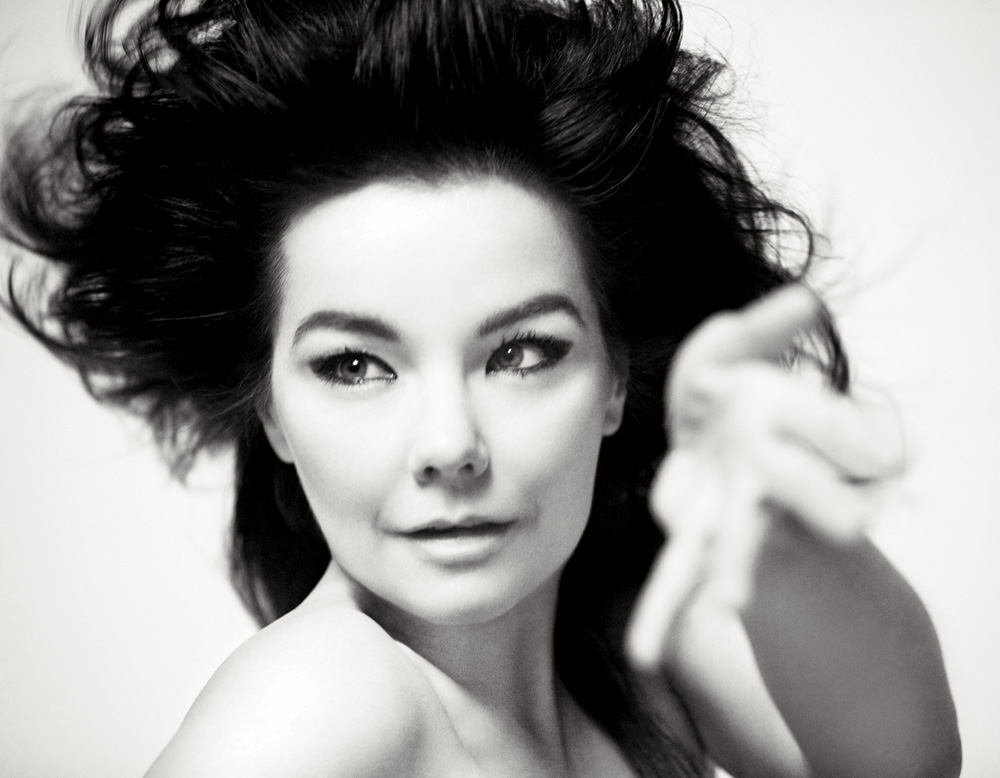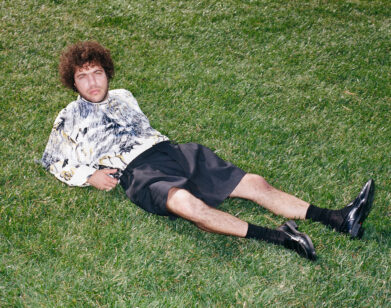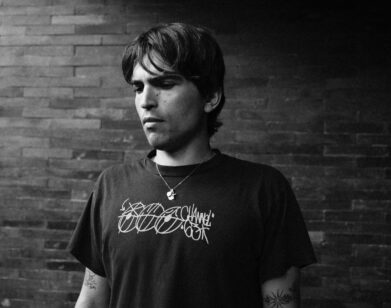The Essential Art of Being Björk

To say that an artist has vision can mean any number of things. It can mean that they have foresight or that they have perceived something that the bulk of us might have missed. It can also mean that they quite literally have visions—psychedelically induced or otherwise. But in Björk’s case, it means that the artist—the one with the vision—has simply dared to imagine something that does not already exist. Which is why vision is as important for a musician as it is for a sculptor or a painter—and why it’s essential to the art of being Björk.
As an artist, one of Björk’s greatest assets has always been her innate understanding of what it means to have vision. What she does as a singer and a songwriter falls somewhere between making records and writing, directing, and starring in her own quasi-folkloric, semi-futuristic, pseudo-theatrical, musical performance-art epics. But embracing her individuality is an impulse from which Björk has rarely ever veered: from the singing that she did with her Icelandic ’80s band the Sugarcubes to her constantly evolving solo career (which began with the release of 1993’s Debut) to her starring role in Lars von Trier’s Dancer in the Dark (2000) and her collaboration with her longtime partner, Matthew Barney, on the 2005 film Drawing Restraint 9, amongst a remarkably diverse array of other smart, inventive, and inspiringly far-flung undertakings. In fact, some of Björk’s work has been so extremely—defiantly—original, that attempting to explain it or analyze it would seem almost misguided. That’s because with Björk, there is no such thing as an extracurricular activity. Singing, acting, dressing, art-making, even cavorting on a boat in Central America, are all part of an intricately woven fabric that runs through a multitude of creative worlds, emotional worlds, brave new worlds, and sometimes otherworldly worlds.
Of course, there is also such a thing as revision, and that process of reviewing and re-evaluatingis one that Björk has undertaken in compiling her new two-CD, two-DVD box set Voltaïc (Nonesuch). The collection includes multiple live recordings of songs from her last two records—2004’s Medúlla and 2007’s Volta—along with assorted remixes and videos, but which are performed in different contexts: The first setconsists of a studio session Björk recorded before she began her tour to support Volta in late 2007; the second features renditions of the songs re-created in a church in her native Reykjavik; and the third captures a live performance in Paris near the end of the tour, exactly one year later.
For the past decade, Björk has collaborated with Interview’s creative directors, Michaël Amzalag and Mathias Augustyniak, of M/M (Paris), and photographers Inez van Lamsweerde and Vinoodh Matadin, who took the pictures that accompany this interview, on virtually all of the imagery, packaging, and artwork for her records, as well as videos, books, and a host of other projects. This pooling of creative forces has not only served to document Björk’s ever-changing interests and output, but also the merging andmelding of five distinct visions into a singular body of work. From their studio in Paris, Amzalagand Augustyniak recently spoke with 43-year-old Björk, who was traveling and recording on a boat in Guatemala.
MATHIAS AUGUSTYNIAK: Hello?
BJÖRK: Hi!
AUGUSTYNIAK: How are you?
BJÖRK: I’m good. So who’s going to start?
AUGUSTYNIAK: Do you want to start? We wrote a series of questions.
BJÖRK: I wrote several questions, too.
AUGUSTYNIAK: Ladies first or boys first?
BJÖRK: Boys first!
MICHAëL AMZALAG: Yeah, but which one of us? [laughs]
AUGUSTYNIAK: So we have known each other for more than 10 years. But we’ve never had a public interview together. Nevertheless, we see the series of works that we have produced together as evidence of an ongoing series of conversations. Do you feel the same about the series of images we have created together over the years?
BJÖRK: Yes, for sure. I’ve always appreciated working with people I have chemistry with, who are friends, and where you feel that the work is growing while you are getting to know each other better. Because the relationship changes as you learn more about people, and the work sort of takes on its own life. I enjoy this very much. We’ve had a lot of conversations, but it’s never directly about the work. I sometimes get a little shy when people try to analyze too much.
AUGUSTYNIAK: I think the same. That’s why doing an interview like this is complicated for us. [Björk laughs] Because we’ve talked a lot, but we’ve never really talked about certain things.
AMZALAG: I don’t really ask questions when we work together. Everything is kind of understood in the process, and that’s why I always prefer to decode what you’re doing, and then make my opinion privately. So maybe I would not be a good journalist . . . But now that we have kind of accepted this game, we have to force -ourselves to try to get things in public.
BJÖRK: Yeah, it’s a sign that you have a good work relationship if you don’t have to analyze. [laughs] That’s usually a good sign within creative work. Should I ask the next question?
AUGUSTYNIAK: Yes, ask the next one.
BJÖRK: I wanted to know if you would ever be interested in building your own house. And where you would want to build it, and what material it would be made out of, and if you would want to paint it. Would you want it to be made of wood or concrete or glass? What color would you paint it?
AUGUSTYNIAK: I have a problem with this because I tend to live where chance leads me. I’m not very good at building a nest. I’m a bit like the cuckoo. I like to find existing nests. I like the idea of a ready-made house.
AMZALAG: I think for me as well—I would be completely embarrassed about having to think about what kind of house I’d build because it would raise too many questions. [laughs]
BJÖRK: I’ve been traveling in Guatemala in the rainforest, and here all these houses are made of sticks. It seems so easy to make one.AUGUSTYNIAK: You’re distracting me from the questions I wanted to ask you! But this house idea does lead me to something I always wanted to ask you: Where are you from? And what is your country? Because it seems like each time I phone you, you’re in a different place, or you’re in between places.
BJÖRK: I guess I’m lucky because I’m from Iceland—you’ve heard about this place, no?
AUGUSTYNIAK: Yes, we have. [all laugh]
BJÖRK: I feel like the people from Iceland have a different relationship with their country than other places. Most Icelandic people are really proud to be from there, and we don’t have embarrassments like World War II where we were cruel to other people. We don’t even have an army. So it’s sort of like an all-around good, -innocent place. Maybe it’s just a personal thing, but I get so much grounding from Iceland because I know it’s always going to be there. I have a very happy, healthy relationship with the country, so it’s really easy to go everywhere because I always have Iceland to go back to. It’s sort of a contradiction, but that’s how it works somehow.
AUGUSTYNIAK: I know you’re not a protest singer, but in your song “Declare Independence,” you say, “Raise your flag!” you know?
BJÖRK: Yes.
AUGUSTYNIAK: You say, “Declare independence!” Would you ever like to be more politically involved?
BJÖRK: No, I don’t think so.
AUGUSTYNIAK: Because even though you’re sometimes far away from your country, you’ve been one of its greatest ambassadors.
BJÖRK: I feel like my last album was really very much about this emotion to want justice. And maybe I go with this emotion as a way to get at how it is to feel injustice—to want justice and to demand it. It’s very strong, this image of a person with a flag, declaring independence. But I’m not interested in politics. I lose interest the microsecond it ceases to be emotional, when something becomes a political movement. What I’m interested in is emotions.
AUGUSTYNIAK: Okay, but maybe you could run your country emotionally.
BJÖRK: [laughs] I’m not sure that I would want to run it. My country would then be very predictable for me—it wouldn’t have any surprises. Now it’s my turn to ask, no?
AUGUSTYNIAK and AMZALAG: Yes.
BJÖRK: I was interested in your relationship with the outdoors. I’ve been working outside a lot in Guatemala, and I’m enjoying very much this outdoor lifestyle. I was curious: If you could choose where you did your work, how many hours a day would you like to spend outside? And then I was also going to ask you: Could you design a computer screen that can handle daylight? It’s really difficult to see on the computer screen on your laptop when you’re outside.
AUGUSTYNIAK: But you can still work outside with a computer. For me, the revolution was when I felt like I could play an electric guitar outside. Now, with a portable computer, I have the feeling that I have a portable workshop. Does that make sense?
BJÖRK: But don’t you find it difficult to see the screen in the sun? There must be a way to make a computer screen that you can see outside. It’s all designed for indoor people. I think it’s very fascist.
AUGUSTYNIAK: So maybe the next technological move is to design a screen that you can use outside?
BJÖRK: Yeah.
AUGUSTYNIAK: But it’s already a bit like this, no? I have noticed that now when you’re outside, the computer screens brighten themselves on their own.
AMZALAG: The latest computers are light sensitive. So they lighten up a bit more when they have, like, strong light coming in.
BJÖRK: Oh, wow. But don’t the screens still have that plasma look, which is hard and doesn’t work well with natural light?
AUGUSTYNIAK: The screens are still not quite all the way there yet, but they’re getting better. Does that answer your question?
BJÖRK: Well, how many hours a day would you like to work outside if you could?AUGUSTYNIAK: I think I could work outside all day long if I was finding ways to do it. I like the idea of being a wanderer, you know? The way I work, my thinking wanders from idea to idea, and I would like to physically do the same.
BJÖRK: What about you, Michaël?
AMZALAG: I think for me it’s kind of the opposite. I think I would be completely unable to work outside. I kind of need to have a specific space—and have my table and my computer. Then I can really get my brain into the things that I need to do. Otherwise, I would be too distracted. I don’t think I’ve ever tried to work outside, but even when I have had to do it I’ve tended to re-create a smaller space where I can focus.
AUGUSTYNIAK: What I like about working outside is sweating while being immobile. Do you know the feeling?
BJÖRK: Yeah. [laughs]
AUGUSTYNIAK: Because you have the sun, but you don’t move—you think, and you work hard. So I like that idea, of sweating but standing still.
BJÖRK: It’s your turn.
AUGUSTYNIAK: Okay. Normally, when we meet, you’ve done a record, and so we just talk about your record, and you’re describing your world. So what do you think of the image we did together for the cover of this magazine? Somehow we see it as a transitory record cover—like between one that’s finished and one that doesn’t exist yet. It’s like a possible record cover for possible songs. What do you think about this image we did together?
BJÖRK: I enjoyed making it very much—especially to be a tool in the hands of people I trust. I find it a very enjoyable game. In a way, it’s more of a game for me because I’m not responsible, so I’m more like a kid, and I get more space to play. When you came up with the idea for the cover, I was very excited and happy not to have this whole burden of having to translate for you two or three years’ work that I’ve been doing. Most times when we do an album cover, I feel like the most important thing for me is to make sure that the cover and the music communicate, you know? I see so many album covers where the music and the cover have no relationship. So when I meet you guys, I always kind of talk for hours and hours to tell you about the universe that the music is. It’s really abstract sometimes, and it’s kind of hard for me to explain. It’s a very intuitive process, too. I just go on explaining and explaining until I see you instinctively understand what I mean. And then you do your work from there. So that is a lot of responsibility for me. It’s almost like I’m putting my child in the right hands. But then when I do photo shoots like we did for this magazine, and you come up with the ideas, it’s really liberating for me. I don’t have to protect some child or anything. I can just come and play, you know?
AMZALAG: Whenever we do a record sleeve together, we try to build this character that depicts the world of the album. In this case, there is no album, but there is a character with a story that’s kind of untold. Do you see this character as a portrait of you, or is it someone detached from you?
AUGUSTYNIAK: Or is it like a friend or like someone parallel to you?
AMZALAG: Or is it more like comedy?
BJÖRK: [laughs] That’s a good question. I don’t think it is me. I think it’s a side in me that I am magnifying and exaggerating with the knowledge that it is a side of everyone. So I look at it more like emotional space. You have 1,000 colors of emotion, and each album is one color exaggerated. It’s so exaggerated that it’s not me, but it’s one color, you know? And I feel like that color is in everyone. Does that make sense?
AUGUSTYNIAK: It does. For me, it’s an exaggerated feeling or human emotion that’s put into a shape.
BJÖRK: I also think it’s fun to play games. People ask me questions like, “Oh, you look so theatrical in your photographs. Is that what you’re like when you walk down the street?” It’s like, “Of course not.” It’s such a silly question—it’s like being theatrical is a crime. I don’t think it’s a crime. I think humans have always needed this. In rituals for thousands and thousands of years, they’ve put on shaman costumes and have had out-of-body experiences. I think there’s a need for the theatrical. It’s very organic and ancient and human. I don’t think it’s artificial.
AUGUSTYNIAK: Each time we work with you on a record cover, I see it as if I was an engineer building your world, but it’s a world I haven’t designed a blueprint for. And then each time I realize that you are the one who designed the blueprint of this world. And then each time this character is super-theatrical so you can make people believe that this world exists. Does that make sense?
BJÖRK: Yeah, I think so. I think it’s a little bit like tarot cards. Each card is very exaggerated in what it stands for, but no person is just one
tarot card.
AUGUSTYNIAK: Do you see yourself as creating parallel realities? Like a little world that’s parallel to the big world so that it balances the image of the world itself?
BJÖRK: Maybe it’s more vertical than parallel. [laughs] If the humans are all horizontal, then to create this kind of mythological color or emotion is vertical.AUGUSTYNIAK: In the editors’ letter, Glenn O’Brien and Christopher Bollen, who work at the magazine, are discussing the cover. At one point they describe the drop beneath your eye, and Glenn says that the drop, in fact, is a tear of knowledge. And he describes the tear of knowledge as one that when it drops onto the floor, it changes the world where it touches it. Does that make sense—what I’m saying to you, the idea of the tear of knowledge?
BJÖRK: Oh, wow.
AUGUSTYNIAK: So what do you think about that? Do you feel like you change the world when you cry?
BJÖRK: [laughs] Now, Mathias, you are projecting your needs of expression . . . Remember: You are the creator of the tear.
AUGUSTYNIAK: But you inspired it. That wasn’t me. It’s like a common thing, you know?
BJÖRK: [laughs] Can I ask a question now?
AUGUSTYNIAK: Yeah, of course.
BJÖRK: I was just going to ask you about music. Did either of you ever learn music or play music? What’s your favorite music? What’s the most inspiring musical instrument?
AUGUSTYNIAK: I myself never learned or played music. I was once secretly part of a band, and our record is the only thing I did in music. But I was never forced by my parents to do music, so maybe this is something I missed.
BJÖRK: What did you play in the band?
AMZALAG: He was singing. [laughs]
AUGUSTYNIAK: That’s the only thing I had—my voice—so I would just sing. And I did the record cover, but I didn’t sign it with my name. I signed it with the name of the band.
AMZALAG: It’s difficult to just simply say, “Oh, I like piano.” But are you asking because you think there are, like, audio people and video people, and maybe that’s why we are different from you?
BJÖRK: No . . . I guess because the way we connect is through the visual—even though I am more of a music person. I was just thinking, we have not talked about how you feel about music for all these years. Of course, I know about your CD collection, Michaël. [laughs] And that does help me a lot in that connection. But I was just curious if there was something else there . . .
AMZALAG: But the music model definitely applies to what we do. One of the ideas we had when we decided to work together was that basically we were forming a band, but we are a band that doesn’t produce albums—that just produces images. So this is why I was asking about the audio people versus the video people. Fo instance Mathias would listen to a record because he liked the sleeve, and then he would force himself to fall into the world of that record just because of the imagery. I think music is a place where we can meet together, but I think we’re also coming from different worlds, and that’s why we’ve been enjoying this collaboration so much—because each of us is able to open doors for the other.
BJÖRK: Yeah, for sure.
AUGUSTYNIAK: I remember once we were discussing music, and I was teasing, and I said, “Oh, I was listening to Phil Collins—you know the song ‘Mama’ [by Genesis]?” And at one point you said, “Shut up. You are too prog.” I remember you saying this. [all laugh] It was kind of a sweet-and-sour insult thing. What did you mean by saying this?
BJÖRK: You don’t have this in French—prog?
AUGUSTYNIAK: Yes, I know what prog-rock is, but I would never treat it as prog. Now each time I’m listening to music, I’m thinking, Oh, maybe I’m too prog here. So then I feel like I see myself as being prog, and I become a bit disgusted. [all laugh] When I’m listening to music, I’m imagining I’m a character myself, you know? And then when you said, “Oh, you’re too prog,” the character was really wrong. Because I was imagining boots, and suddenly the look of prog didn’t fit me anymore.
BJÖRK: I mean, I think there’s prog of every decade—the prog of the ’70s is probably most famous. But I think we have prog today. You could say maybe Aphex Twin is prog . . . neo-prog. [laughs]
AUGUSTYNIAK: Okay. Then it makes sense to me because I feel, “Oh, it’s cool again.”
BJÖRK: Yeah. I mean, Aphex Twin would probably beat me in the head for saying that, but there you go. AUGUSTYNIAK: So you are going to release this live album, Voltaïc. Somehow, it’s the first time you’re doing a real live album. I mean, you’ve released compilations of live recordings before, but this one is different, no?
BJÖRK: I did all those box sets when I was pregnant and breast-feeding. I used the nesting hormones to become a librarian, and I went through like 10 or 15 years of live recordings—I can’t remember—and listened to them and compiled them so I would have my favorite version of each song. But I guess what’s different with Voltaïc is that we played the songs live just last year, so it’s still kind of fresh.
AUGUSTYNIAK: That’s kind of a new exercise for you, no?
BJÖRK: Yeah. We recorded the songs in a kind of radio room before the tour as we were doing rehearsals—and then we recorded them again in Paris once the tour was almost finished. The tour was 18 months total, so there was really a long time between recordings.
AMZALAG: When I was working on the credits on the album, I was amazed because the date of the recording in the studio is exactly a year before the date of the live recording. It’s the same songs, only recorded a year apart, on June 25, which by the way happens to be the birthday of Carly Simon and George Orwell—I had to check on Wikipedia.
BJÖRK: And then, of course, there’s the recording we did in the church in Iceland, which was very spontaneous. We just set up there because, with the recordings we’d done in Paris, I didn’t feel like we really reached the more quiet, calm songs. So I wanted to re-record them in a different environment. There were a lot of songs on Volta—like “Pneumonia,” for example—which I did two times in a festival atmosphere. So in a way it’s three things: It’s the radio concert; it’s the live concert; and then it’s a performance in a more quiet environment with a choir. I also never really toured for the record Medúlla before, so in a way this Voltaïc set is not only doing music from Volta, but also from Medúlla.
AUGUSTYNIAK: So basically this live album is a real documentary of your different views of your voice?
BJÖRK: Yeah, a little bit.
This is an excerpt of the June cover story. To read the full Björk interview pick up a copy of Interview.
Mathias Augustyniak & Michaël Amzalagare are Interview’s creative directors.







